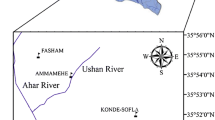Abstract
Suspended sediment load (SSL) prediction in streams or rivers is essential for sustainable environmental systems and water resource engineering. Sediment has a major influence on working capacity of reservoir and dams. In last two decades, data-driven models have been commonly used for modelling hydrological phenomena that are complex in nature. In this study, support vector machine (SVM) with fruit fly optimisation algorithm (SVM-FOA) has been employed to predict SSL at Rajghat station of Narmada river basin, India utilising collected hydro-meteorological data. Accuracy of SVM and SVM-FOA models was assessed based on statistical indices and graphical representation. Statistical assessment reveals that prediction by SVM-FOA model was significantly better than traditional SVM model. Overall, applied hybrid artificial intelligence model achieved excellent SSL prediction.
Access this chapter
Tax calculation will be finalised at checkout
Purchases are for personal use only
Similar content being viewed by others
References
Afan HA, El-Shafie A, Yaseen ZM, Hameed MM, Wan Mohtar WHM, Hussain A (2014) ANN based sediment prediction model utilizing different input scenarios. Water Resour Manage 29(4):1231–1245
Agnihotri A, Sahoo A, Diwakar MK (2022) Flood prediction using hybrid ANFIS-ACO model: a case study. In: Inventive computation and information technologies. Springer, Singapore, pp 169–180
Cong Y, Wang J, Li X (2016) Traffic flow forecasting by a least squares support vector machine with a fruit fly optimization algorithm. Procedia Eng 137:59–68
Cristianini N, Shawe-Taylor J (2000) An introduction to support vector machines and other kernel-based learning methods. Cambridge University Press, New York
Farfani HA, Behnamfar F, Fathollahi A (2015) Dynamic analysis of soil-structure interaction using the neural networks and the support vector machines. Expert Syst Appl 42(22):8971–8981
Jain SK (2012) Modeling river stage–discharge–sediment rating relation using support vector regression. Hydrol Res 43(6):851–861
Kaveh K, Bui MD, Rutschmann P (2017) A comparative study of three different learning algorithms applied to ANFIS for predicting daily suspended sediment concentration. Int J Sedim Res 32(3):340–350
Kecman V (2001) Learning and soft computing: support vector machines, neural networks, and fuzzy logic models. MIT Press, Cambridge
Kumar D, Pandey A, Sharma N, Flügel WA (2015) Modeling suspended sediment using artificial neural networks and TRMM-3B42 version 7 rainfall dataset. J Hydrol Eng 20(6):C4014007
Lafdani EK, Nia AM, Ahmadi A (2013) Daily suspended sediment load prediction using artificial neural networks and support vector machines. J Hydrol 478:50–62
Mohanta NR, Biswal P, Kumari SS, Samantaray S, Sahoo A (2021) Estimation of sediment load using adaptive neuro-fuzzy inference system at Indus River Basin, India. In: Intelligent data engineering and analytics. Springer, Singapore, pp 427–434
Pan WT (2012) A new fruit fly optimization algorithm: Taking the financial distress model as an example. Knowl Based Syst 26:69–74
Sahoo A, Samantaray S, Ghose DK (2019) Stream flow forecasting in mahanadi river basin using artificial neural networks. Procedia Comput Sci 157:168–174
Sahoo A, Samantaray S, Bankuru S, Ghose DK (2020) Prediction of flood using adaptive neuro-fuzzy inference systems: a case study. In: Smart intelligent computing and applications. Springer, Singapore, pp 733–739
Sahoo A, Barik A, Samantaray S, Ghose DK (2021) Prediction of sedimentation in a watershed using RNN and SVM. In: Communication software and networks. Springer, Singapore, pp 701–708
Samantaray S, Tripathy O, Sahoo A, Ghose DK (2020) Rainfall forecasting through ANN and SVM in Bolangir Watershed, India. In: Smart intelligent computing and applications. Springer, Singapore, pp 767–774
Samantaray S, Sahoo A, Ghose DK (2020) Prediction of sedimentation in an arid watershed using BPNN and ANFIS. In: ICT analysis and applications. Springer, Singapore, pp 295–302
Shen L, Chen H, Yu Z, Kang W, Zhang B, Li H, Yang B, Liu D (2016) Evolving support vector machines using fruit fly optimization for medical data classification. Knowl-Based Syst 96:61–75
Sivapragasam C, Maheswaran R, Venkatesh V (2008) Genetic programming approach for flood routing in natural channels. Hydrol Process 22(5):623–628
Sridharam S, Sahoo A, Samantaray S, Ghose DK (2021) Assessment of flow discharge in a river basin through CFBPNN, LRNN and CANFIS. In: Communication software and networks. Springer, Singapore, pp 765–773
Sudheer C, Kumar D, Prasad RK, Mathur S (2013) Optimal design of an in-situ bioremediation system using support vector machine and particle swarm optimization. J Contam Hydrol 151:105–116
Sun X, Bi Y, Karami H, Naini S, Band SS, Mosavi A (2021) Hybrid model of support vector regression and fruitfly optimization algorithm for predicting ski-jump spillway scour geometry. Eng Appl Comput Fluid Mech 15(1):272–291
Taşar B, Kaya YZ, Varçin H, Üneş F, Demirci M (2017) Forecasting of suspended sediment in rivers using artificial neural networks approach. Int J Adv Eng Res Sci 4(12):237333
Vapnik V (1995) The nature of statistical learning theory. Data mining and knowledge discovery. Springer-Verlag, New York, NY, USA, pp 1–47
Author information
Authors and Affiliations
Corresponding author
Editor information
Editors and Affiliations
Rights and permissions
Copyright information
© 2022 The Author(s), under exclusive license to Springer Nature Singapore Pte Ltd.
About this paper
Cite this paper
Sahoo, A., Samantaray, S., Sathpathy, D.P. (2022). Prediction of Sediment Load Through Novel SVM-FOA Approach: A Case Study. In: Bhateja, V., Khin Wee, L., Lin, J.CW., Satapathy, S.C., Rajesh, T.M. (eds) Data Engineering and Intelligent Computing. Lecture Notes in Networks and Systems, vol 446. Springer, Singapore. https://doi.org/10.1007/978-981-19-1559-8_30
Download citation
DOI: https://doi.org/10.1007/978-981-19-1559-8_30
Published:
Publisher Name: Springer, Singapore
Print ISBN: 978-981-19-1558-1
Online ISBN: 978-981-19-1559-8
eBook Packages: Intelligent Technologies and RoboticsIntelligent Technologies and Robotics (R0)




